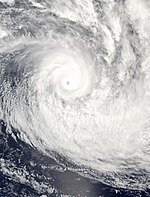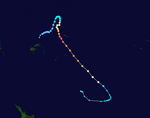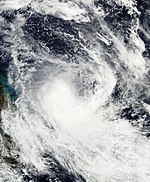2003–04 South Pacific cyclone season
| 2003–04 South Pacific cyclone season | |
|---|---|
 Season summary map | |
| Seasonal boundaries | |
| First system formed | December 4, 2003 |
| Last system dissipated | April 24, 2004 |
| Strongest storm | |
| Name | Heta |
| • Maximum winds | 215 km/h (130 mph) (10-minute sustained) |
| • Lowest pressure | 915 hPa (mbar) |
| Seasonal statistics | |
| Total disturbances | 15 |
| Total depressions | 12 |
| Tropical cyclones | 3 (Record Low, tied with 2011-12) |
| Severe tropical cyclones | 2 |
| Total fatalities | 16 |
| Total damage | $387 million (2004 USD) |
| Related articles | |
The 2003–04 South Pacific cyclone season was a below-average season with only three tropical cyclones occurring within the South Pacific to the east of 160°E. The season officially ran from November 1, 2003 to April 30, 2004 with the first disturbance of the season forming on December 4 and the last disturbance dissipating on April 23.[A 1][A 2] This is the period of the year when most tropical cyclones form within the South Pacific Ocean.[1]
During the season at least 16 people were killed from tropical disturbances whilst overall damage was estimated at $218 million (2004 USD; $299 million 2022 USD). The most damaging tropical disturbance was Cyclone Heta which caused at least $211 million (2004 USD; $289 million 2022 USD) in damage to six different countries and left three dead.[2][3][4] The deadliest tropical disturbance of the season was Tropical Depression 10F, which was responsible for eleven deaths and caused $2.74 million (2004 USD) in damage.[5] Cyclone Ivy also caused 2 deaths and caused $4.17 million (2004 USD; $5.72 million 2022 USD) worth of damage to Vanuatu.[2][6] As a result of the impacts caused by Heta and Ivy, the names were retired from the tropical cyclone naming lists.[1]
Within the South Pacific, tropical cyclones are monitored by the Regional Specialized Meteorological Center (RSMC) in Nadi, Fiji, and the Tropical Cyclone Warning Center (TCWC) in Wellington, New Zealand. RSMC Nadi attaches a number and an F suffix to tropical disturbances that form in or move into the South Pacific. The United States Joint Typhoon Warning Center (JTWC) issues unofficial warnings within the South Pacific, designating tropical cyclones with a number and a P suffix. RSMC Nadi and TCWC Wellington both use the Australian Tropical Cyclone Intensity Scale, and measure windspeeds over a period of ten minutes, while the JTWC measures sustained winds over a period of one minute and uses the Saffir–Simpson Hurricane Scale.
Seasonal summary[]

Systems[]
Severe Tropical Cyclone Heta[]
| Category 5 severe tropical cyclone (Australian scale) | |
| Category 5 tropical cyclone (SSHWS) | |
  | |
| Duration | December 28 – January 7 |
|---|---|
| Peak intensity | 215 km/h (130 mph) (10-min) 915 hPa (mbar) |
Cyclone Heta developed in the South Pacific Ocean and reached cyclone-force winds on January 1, 2004. It struck the island of Niue with a much more direct blow on January 6. Heta's eyewall hit Niue almost exactly at the height of the storm's power. It caused extensive property damage throughout the island, and two people were killed. Efforts to rebuild from the storm in Niue lasted almost the entire year of 2004.
Heta caused American Samoa to declare a state of emergency (officially a "Declaration of Emergency" in American Samoan law) on January 7, and even though officially the storm never made landfall there, it necessitated the emergency evacuation of 140 people and was responsible for property damage.[7]
The nation of Tonga was also affected by Heta, as the winds swept away trees that were needed for the country's food supply. However, Tonga did not receive a direct hit or suffer such extensive loss as Niue.
Severe Tropical Cyclone Ivy[]
| Category 4 severe tropical cyclone (Australian scale) | |
| Category 3 tropical cyclone (SSHWS) | |
  | |
| Duration | February 21 – February 28 |
|---|---|
| Peak intensity | 165 km/h (105 mph) (10-min) 935 hPa (mbar) |
Numbered 05F. Existed between February 21 and February 28. Caused heavy damage in Vanuatu.[8]
Tropical Depression 06F[]
| Tropical depression (Australian scale) | |
 | |
| Duration | March 20 – March 22 |
|---|---|
| Peak intensity | Winds not specified |
Formed on March 20, dumped heavy rainfall in Vanuatu.[9][10] 06F was last noted on March 22.
Tropical Cyclone Grace[]
| Category 2 tropical cyclone (Australian scale) | |
| Tropical storm (SSHWS) | |
  | |
| Duration | March 21 – March 23 |
|---|---|
| Peak intensity | 95 km/h (60 mph) (10-min) 985 hPa (mbar) |
Entered the region from the west on March 23, became extratropical the next day.[11] Designated as 07F by Nadi.[9]
Tropical Depression 08F[]
| Tropical depression (Australian scale) | |
 | |
| Duration | March 28 – April 1 |
|---|---|
| Peak intensity | Winds not specified |
Existed between March 28 and April 1.[9]
Tropical Depression 09F[]
| Tropical depression (Australian scale) | |
 | |
| Duration | April 1 – April 3 |
|---|---|
| Peak intensity | Winds not specified |
Existed between April 1 and April 3.[12]
Tropical Depression 10F[]
| Tropical depression (Australian scale) | |
| Tropical storm (SSHWS) | |
  | |
| Duration | April 5 – April 9 |
|---|---|
| Peak intensity | 55 km/h (35 mph) (10-min) 995 hPa (mbar) |
Existed between April 6 and April 9. The storm was given the number 22P by the Joint Typhoon Warning Center. It was responsible for causing severe flooding to Fiji and 11 deaths.[12][13][14] Damage from the flooding was estimated at US$2.6 million.[15]
Tropical Depression 12F[]
| Tropical depression (Australian scale) | |
 | |
| Duration | April 7 – April 13 |
|---|---|
| Peak intensity | Winds not specified |
Formed on April 7, later caused severe flooding in Fiji.[12] 12F was last noted on April 13.
Tropical Depression 13F[]
| Tropical depression (Australian scale) | |
 | |
| Duration | April 11 – April 13 |
|---|---|
| Peak intensity | Winds not specified |
During April 11 a weak tropical low moved into the South Pacific basin from the Australian region, and was designated as Tropical Disturbance 13F by RSMC Nadi later that day.[12] 13F was last noted on April 13 as a Tropical Depression.
Other systems[]
The first numbered tropical disturbance of the season developed within a large area of atmospheric convection on December 4, to the northwest of the Fijian dependency of Rotuma.[16] During that day the depression slowly moved west, before it was classified as a weak tropical depression during the next day.[17][18] The system subsequently weakened and lost its organisation because of moderate to strong vertical windshear and was last noted during December 6.[19][20]
Tropical Disturbance 02F was first noted by the FMS during December 16, within an environment conducive for further development, about 340 km (210 mi) to the west of Honiara in the Solomon Islands.[21][22] Over the next few days, the system remained poorly organised and slow-moving within an area of moderate vertical windshear, before it was last noted by the FMS during December 20, as it entered the Australian region.[23][24] Tropical Disturbance 04F was subsequently first noted within a broad area of low pressure by the FMS, while it was located on the border with the South Pacific basin, about 100 km (60 mi) to the south of Honiara in the Solomon Islands.[25] The system was located in a moderate area of vertical windshear and was poorly organised with atmospheric convection confined to the system's eastern semicircle.[25] The system subsequently moved south-eastwards and remained poorly organised, before it was last noted by the FMS later that day while it was located to the south of San Cristobal Island.[26]
During April 6, the FMS reported that Tropical Depression 11F had developed within a monsoon trough, about 140 km (85 mi) to the north-east of Suva in Fiji.[27][28] Over the next day, the system moved south-eastwards towards Tonga, before it was last noted by the FMS later that day, while it was located about 300 km (185 mi) to the southwest of Tongatapu in Tonga.[28][29][12]
On April 18, RSMC Nadi reported that Tropical Disturbance 14F had developed within the monsoon trough, about 515 km (320 mi) to the northeast of Nukuʻalofa in Tonga.[12][30] During that day, the disturbance moved through the Tongan archipelago, before it was last noted later that day.[12]
During April 22, the FMS reported that Tropical Disturbance 15F had developed around 500 km (310 mi) to the northeast of Honiara in the Solomon Islands.[31] Over the next couple of days, the system remained poorly organised and near stationary to the northeast of the Solomon Islands, before it was last noted during April 24.[12][32]
Season effects[]
This table lists all the storms that developed in the South Pacific to the east of longitude 160°E during the 2003–04 season.
| Name | Dates active | Peak classification | Sustained wind speeds |
Pressure | Areas affected | Damage (USD) |
Deaths | Refs |
|---|---|---|---|---|---|---|---|---|
| 01F | December 4 – 6 | Tropical Depression | Not Specified | 1005 hPa (29.68 inHg) | None | None | None | |
| 02F | December 16 – 20 | Tropical Disturbance | Not Specified | 1000 hPa (29.53 inHg) | Solomon Islands | None | None | |
| Heta | December 25 – January 8 |
Category 5 severe tropical cyclone | 215 km/h (130 mph) | 915 hPa (27.02 inHg) | Samoan Islands, Niue, Tonga, Wallis and Futuna | $225 million | 3 | [33][34][35][36] |
| 04F | December 29 | Tropical Disturbance | Not Specified | 1004 hPa (29.65 inHg) | Solomon Islands | None | None | |
| Ivy | February 21 – 28 | Category 4 severe tropical cyclone | 165 km/h (105 mph) | 935 hPa (27.61 inHg) | Vanuatu, Solomon Islands, New Caledonia, New Zealand | $3.8 million | 4 | |
| 06F | March 20 – 22 | Tropical Depression | Not Specified | Not Specified | None | None | None | |
| Grace | March 21 – 23 | Category 2 tropical cyclone | 95 km/h (60 mph) | 985 hPa (29.11 inHg) | None | None | None | |
| 08F | March 28 – April 1 | Tropical Depression | Not Specified | Not Specified | None | None | None | |
| 09F | April 1 – 3 | Tropical Depression | Not Specified | Not Specified | None | None | None | |
| 10F | April 5 – 9 | Tropical Depression | 55 km/h (35 mph) | 995 hPa (29.38 inHg) | Fiji | $4.17 million | 11 | |
| 11F | April 6 – 7 | Tropical Depression | Not Specified | Not Specified | None | None | None | |
| 12F | April 7 – 13 | Tropical Depression | Not Specified | Not Specified | Fiji | None | None | |
| 13F | April 11 – 13 | Tropical Depression | Not Specified | Not Specified | None | None | None | |
| 14F | April 18 – 19 | Tropical Disturbance | Not Specified | 1006 hPa (29.71 inHg) | Tonga | None | None | [12] |
| 15F | April 22 – 24 | Tropical Disturbance | Not Specified | 1006 hPa (29.71 inHg) | None | None | None | [12] |
| Season aggregates | ||||||||
| 15 systems | December 4 – April 24 | 215 km/h (130 mph) | 915 hPa (27.02 inHg) | $387 million | 16 | |||
See also[]
- List of Southern Hemisphere tropical cyclone seasons
- Tropical cyclones in 2004
- Atlantic hurricane seasons: 2003, 2004
- North Indian Ocean cyclone seasons: 2003, 2004
- Pacific hurricane seasons: 2003, 2004
- Pacific typhoon seasons: 2003, 2004
Notes[]
References[]
- ^ a b "Tropical Cyclone Operational Plan for the South Pacific and South-East Indian Ocean (2008 Edition)" (PDF). World Meteorological Organization. Archived (PDF) from the original on May 22, 2009. Retrieved May 26, 2010.
- ^ a b "Economic impact of Natural Disasters on development in the Pacific" (PDF). Australian Agency for International Development, University of the South Pacific. Pacific Disaster.net. 2005. Archived from the original (PDF) on February 25, 2010. Retrieved June 2, 2010.
- ^ "Tropical Cyclone Season Summary 2003–04" (PDF). Fiji Meteorological Service. August 29, 2007. Archived from the original (PDF) on July 27, 2010. Retrieved November 15, 2012.
- ^ "American Samoa Event Report: Tropical Cyclone Heta". National Climatic Data Center. 2004. Archived from the original on April 18, 2010. Retrieved June 2, 2010.
- ^ "Tropical Cyclone Country reports: 2006–08 Fiji" (PDF). Fiji Meteorological Service. World Meteorological Organization. Archived from the original (PDF) on June 2, 2010. Retrieved June 2, 2010.
- ^ "A Special Submission to the UN Committee for Development Policy on Vanuatu's LDC Status" (PDF). United Nations. March 4, 2009. Archived from the original (PDF) on February 25, 2010. Retrieved August 7, 2009.
- ^ "Summary of South Pacific and South Indian Ocean Tropical Cyclones". 2004 Annual Tropical Cyclone Report. Joint Typhoon Warning Center. Retrieved December 2, 2007.
- ^ Monthly Global Tropical Cyclone Summary February 2004
- ^ a b c Monthly Global Tropical Cyclone Summary March 2004
- ^ "Tropical depression affects south of Vanuatu". Radio New Zealand International. March 22, 2004. Retrieved September 18, 2011.
- ^ "Tropical Cyclone Information for Australia and Southern Hemisphere". Australian Bureau of Meteorology. Archived from the original on September 23, 2015. Retrieved December 2, 2007.
- ^ a b c d e f g h i j Padgett, Gary. "Monthly Global Tropical Cyclone Summary April 2004". Archived from the original on November 10, 2012. Retrieved February 11, 2020.
- ^ "Floods hit Fiji". The New Zealand Herald. June 5, 2004.
- ^ The South Pacific and southeast Indian Ocean tropical cyclone season 2003–04
- ^ "Fiji flood bill tipped to be over $2.6 million". The New Zealand Herald. April 18, 2004.
- ^ RSMC Nadi Tropical Cyclone Centre (December 4, 2003). "Tropical Disturbance Summary December 4, 2003 00z". Fiji Meteorological Service. Retrieved July 13, 2015.
- ^ RSMC Nadi Tropical Cyclone Centre (December 4, 2003). "Tropical Disturbance Summary December 4, 2003 23z". Fiji Meteorological Service. Retrieved July 13, 2015.
- ^ RSMC Nadi Tropical Cyclone Centre (December 5, 2003). "Tropical Disturbance Summary December 5, 2003 09z". Fiji Meteorological Service. Retrieved July 13, 2015.
- ^ Padgett, Gary (October 26, 2006). "Monthly Global Tropical Cyclone Summary December 2003". Retrieved July 13, 2015.
- ^ RSMC Nadi Tropical Cyclone Centre (December 6, 2003). "Tropical Disturbance Summary December 6, 2003 23z". Fiji Meteorological Service. Retrieved July 13, 2015.
- ^ "Tropical Disturbance Summary December 16, 2003 23z". Fiji Meteorological Service. December 16, 2003. Retrieved July 13, 2015.
- ^ "Tropical Disturbance Summary December 17, 2003 23z". Fiji Meteorological Service. December 17, 2003. Retrieved July 13, 2015.
- ^ "Tropical Disturbance Summary December 18, 2003 23z". Fiji Meteorological Service. December 18, 2003. Retrieved July 13, 2015.
- ^ "Tropical Disturbance Summary December 20, 2003 23z". Fiji Meteorological Service. December 20, 2003. Retrieved July 13, 2015.
- ^ a b Tropical Disturbance Summary December 29, 2003 06z (Report). Fiji Meteorological Service. December 29, 2003. Retrieved February 11, 2020.
- ^ Tropical Disturbance Summary December 29, 2003 21z (Report). Fiji Meteorological Service. December 29, 2003. Retrieved February 11, 2020.
- ^ Tropical Disturbance Summary April 7, 2004 00z (Report). Fiji Meteorological Service. April 6, 2004. Retrieved February 11, 2020.
- ^ a b Tropical Disturbance Summary April 7, 2004 09z (Report). Fiji Meteorological Service. April 6, 2004. Retrieved February 11, 2020.
- ^ Tropical Disturbance Summary April 8, 2004 00z (Report). Fiji Meteorological Service. April 8, 2004. Retrieved February 11, 2020.
- ^ RSMC Nadi – Tropical Cyclone Centre (April 19, 2004). Tropical Disturbance Summary April 19, 2004 00z (Report). Fiji Meteorological Service.
- ^ Tropical Disturbance Summary April 20, 2004 10z (Report). Fiji Meteorological Service. April 20, 2004. Retrieved February 11, 2020.
- ^ Tropical Disturbance Summary April 24, 2004 01z (Report). Fiji Meteorological Service. April 24, 2004. Retrieved February 11, 2020.
- ^ Université Catholique de Louvain. "EM-DAT: The OFDA/CRED International Disaster Database for North America". Archived from the original on June 21, 2007. Retrieved May 3, 2014.
- ^ McKenzie, Emily; Prasad, Binman; Kaloumaira, Atu (2005). "Economic Impact of Natural Disasters on development in the Pacific Volume 1: Research Report" (PDF). South Pacific Applied Geoscience Commission. pp. 10–89. Archived from the original (PDF) on February 25, 2010. Retrieved June 29, 2010.
- ^ RSMC Nadi — Tropical Cyclone Centre (2005). "RSMC Nadi Tropical Cyclone Seasonal Summary 2003–04" (PDF). Fiji Meteorological Service. Archived from the original (PDF) on July 27, 2010. Retrieved July 27, 2010.
- ^ Unattributed (2003). "Storm events for American Samoa: Severe Tropical Cyclone Heta". National Climatic Data Center. National Oceanic and Atmospheric Administration. Archived from the original on July 31, 2010. Retrieved July 31, 2010.
External links[]
- 2003–04 South Pacific cyclone season
- South Pacific cyclone seasons
- Tropical cyclones in 2003
- Tropical cyclones in 2004
